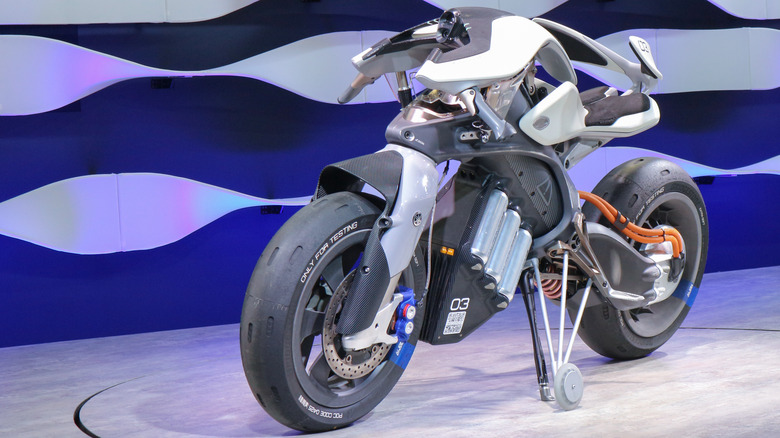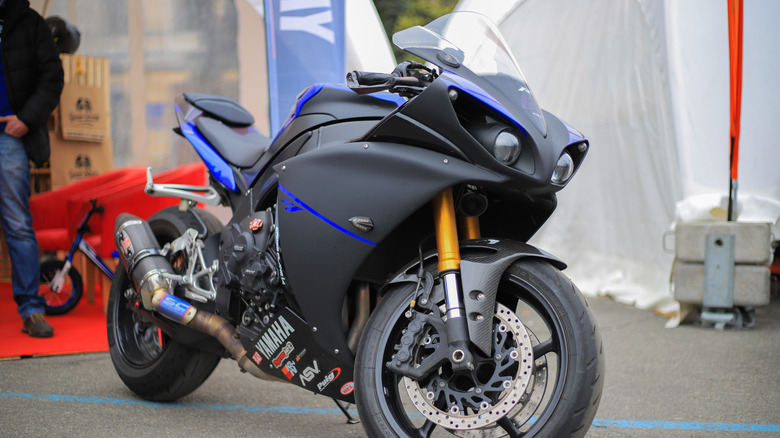6 Of The Most Legendary Yamaha Motorcycles Every Enthusiast Should Know About
Yamaha is one of the biggest names in motorcycles. The company began in 1887, with founder Torakusu Yamaha first developing a reputation as a musical instrument manufacturer. Yamaha Corporation and Yamaha Motor split into two separate entities almost a century later, but it's clear that motorcycles have become one of the company's most famous products.
Yamaha's motorcycle portfolio contains everything from the rather modest yet rather brilliant Chappy to the intriguing three-wheeled tourer that is the Niken GT. Everyone has their own favorite Yamaha model, and it'll depend entirely on what you're looking for in a bike: a comfortable and practical model you can ride yourself, a state-of-the-art racer you can watch screaming around the track (or scream yourself), or a rarity you can keep under wraps or admire in museums.
We've already ranked a selection of the fastest bikes in Yamaha's history, but it takes more than speed alone to make a motorcycle iconic. From their specs to their unique places in Yamaha's story, each of these bikes has that special something that makes them legendary. Some have long since gone out of production, one was a concept model that may never reach that stage, and some you may even own yourself. All, however, are impressive and influential models.
Yamaha YA-1
The YA-1 was the company's very first motorcycle design, and was released in 1955 (the original prototype having emerged six months prior), with a clean design that arguably had rather more aesthetic appeal than a lot of models of the time.
The Red Dragonfly – as it became known for its bright and unique color scheme — was a major departure for the company, based upon the DKW RT125 (a German design that was not patent-protected in the wake of World War II). As the very first Yamaha model, there was no denying its significance to the brand at large, but what truly made it legendary was what a remarkable foundation it laid for Yamaha motorcycles. It's not easy to get everything right the first time, but the YA-1 was a valiant effort indeed.
With a 123cc engine and 5.6 ps (5.52 hp), it was a potent offering for everyday riding and acquitted itself well in hillclimb races. The YA-1 was produced only for the 1955, '56, and '57 model years, but the fact that manufacture increased more than fourfold from 2,272 the first year to 11,000 by the end of its run proved one thing: Yamaha's designers had what it took to create a motorcycle people wanted to ride. The company would continue to do so for decades to come.
[Image by Derek A. via Wikimedia Commons | cropped and resized | CC BY-SA 2.0]
Yamaha YZ450FX
While some Yamaha models were made for everyday urban riding, the company's standing in the motocross world couldn't have been achieved without some formidable off-road options. Of these, the most notable offering of all is perhaps the YZ450FX. In July 2023, Yamaha Motor Europe celebrated the 50th anniversary of the YZ models, boasting that the family had achieved 34 motorcross FIM world title victories.
2024's YZ450FX has a 450 cc 4-valve engine, and comes as standard in a Team Yamaha Blue color scheme that reflects its place as a formidable competitor in the motocross world (alongside the YZ450F pictured here). Veteran riders have had impressive results using it, and in some very unconventional ways, too. In March 2024, two Yamaha models were used to achieve Guinness World Records: one for reaching the highest altitude on a single-cylinder machine, and the other for doing the same on a two-cylinder. Those were the YZ450FX and the Ténéré World Raid GYTR, respectively, and they were ridden by the same man.
These are not models unaccustomed to a bit of challenging terrain, but Chile's majestic Ojos del Salado volcano lent new meaning to the concept of "difficult terrain." Pol Tarres, Yamaha noted, was the rider who accomplished these feats at the volcano, in the first instance "ascending to 6.756 meters on the cross-country specific Yamaha YZ450FX." The company reports that this was achieved while pursuing opportunities for what would become a 6.677-meter ascent on the Tenere.
Yamaha Motoroid
Riders may be familiar with some of the unique and bizarre concept motorcycles that manufacturers have shown off over the years. In the Yamaha stable, there's perhaps been nothing more unusual than the Motoroid and its follow-up.
The 2017 Tokyo Motor Show played host to the first reveal of this extraordinary vehicle, and Yamaha describes it as an "experimental proof-of-concept model [that] employs artificial intelligence and explores creating new forms of personal mobility in which the rider resonates harmoniously with the machine." The motorcycle faithful probably think they know how it feels to resonate harmoniously with their rides, but the Motoroid takes the concept to a frightening new level: It's not nearly as reliant on its rider as a conventional bike.
Resembling any other futuristic, angular sports bike to the uninitiated, Motoroid was actually a development on the Motobot, the company's biker robot that had itself first been shown off at the Tokyo Motor Show two years earlier. The next step for Yamaha, it seems, was to develop a motorcycle that could act as a "living machine." Freshly built from the ground up to incorporate the likes of a haptic human-machine interface, image recognition, an Active Mass Center Control System, and other AI software, it can identify and interact with its owner. It can also keep itself upright independently while in motion. The concept was further developed with the Motoroid2's debut in 2023, and could have a big part to play in the autonomous driving tech of the future.
Yamaha YZF-R1
How long does it take to become a true legend? For some, it's a status that has to be slowly built up, and earned over time. You might be of the school of thought, then, that the YZF-R1 is too new to have proven itself as truly legendary. After all, the second generation of the R1, true full-fledged racing machine that it was, wasn't released until 2015. With a special machine like this one, though, that's arguably more than enough time.
The very first R1 was introduced in 1998, intended as a follow-up to the YZF1000R Thunderace. The objectives behind its design were to devise a model that boasted a potent power of approximately 150 bhp, while limiting its size and weight to ensure an aerodynamic ride. The Thunderace certainly wasn't known for its subtlety, with an MCN review dubbing "the big old 1003cc five-valver ... a meaty, proven and fast motorcycle," and the R1 did a fantastic job of building on those formidable foundations.
The R series scarcely needs introduction, with the R1 perhaps being the most recognizable model in the family. The $18,399 2024 R1, with its four-cylinder 998cc engine, offers approximately 197 horsepower and 83.3 lb-ft of torque. It's a stunning speedster in a relatively small and lightweight package, measuring 80.9 inches long by 27.2 inches wide. It's an iconic model that stands proud alongside anything else in Yamaha's extensive motorcycle lineup.
Yamaha Nehmesis
A-list tastes aren't like those of the rest of us. Properties all around the world, garages full of collections of high-end vehicles, meals at the most lavish restaurants imaginable, private jets — what a life it must be. There are some things, however, that money cannot buy. The mind-blowing Yamaha Nehmesis is one of those things.
This bright and gaudy model is the result of an enormous labor of love from Sam Nehme, who started the project in 2007. He told Ultimate Motorcycling, "I've never been a 'skull-and-bones' builder. I wanted something inspired by the Alien theme, and the bike does have that same quality — sexy, and at the same time, a little scary." BMS Choppers' Nehme is known for creating some of the most unique and ostentatious custom bikes, and few could be considered as outlandish as Nehmesis: a Yamaha Road Star 1700 with a gleaming sense of style like no other.
The furthest thing from the plain-colored 1700 riders will be accustomed to, it's a gold-plated beast that has been estimated to be worth approximately $500,000 – factoring in the enormous six-month time-sink the project involved. One-of-a-kind custom models from some of the best in the business, needless to say, don't come cheap, and neither did the components used in this magnificent model: rims that cost approximately $25,000 help explain why this is so valuable, and, in turn, so ludicrously desirable. Subtle, it certainly isn't, but there may never have been a more eye-catching Yamaha.
Yamaha MT-07
There's no denying Yamaha's place as a titan of the motorcycle world. Statista estimates that, by 2029, the company will hit an annual sales figure of around 5.22 million bikes. Of its most popular models, the MT-07 has really become the stuff of legend, and for good reason.
The MT-07 isn't a monstrous speed machine like the YZF-R1, nor is it a unique rarity like the acclaimed Nehmesis. Sometimes, though, practicality, utility, and reliability are the most important metrics of all, and this is where the 07 absolutely excels.
Yamaha has been refining its MT (Mega Torque) line since the MT-01's initial appearance in 1999, and the 07 launched 15 years later. It has remained popular ever since, with Yamaha boasting that the 160,000-seller is its most popular Hyper Naked and has been so since its inception. The 2024 MT-07 features a 4-valve liquid-cooled 689cc engine, along with 67.0 Nm (approximately 49 lb-ft) of torque. Starting at $8,199, it may not be the cheapest model, but it certainly offers considerable power for the price.
The MT-07 has risen to such acclaim, then, largely by virtue of having a combination of some of the most desirable traits a rider could ever want: affordability, a striking style, and performance that won't overwhelm beginner riders nor disappoint veterans. This is a very difficult balance to achieve, but it means that the MT-07 has a wide appeal that few other Yamaha models could match.





